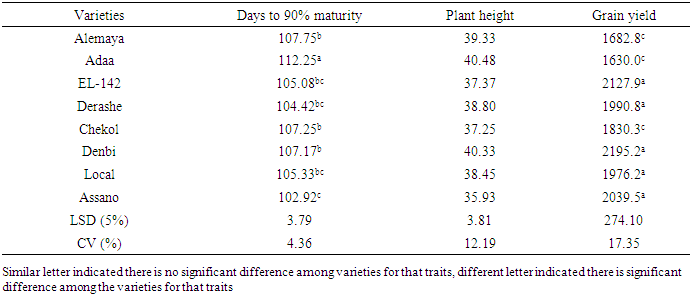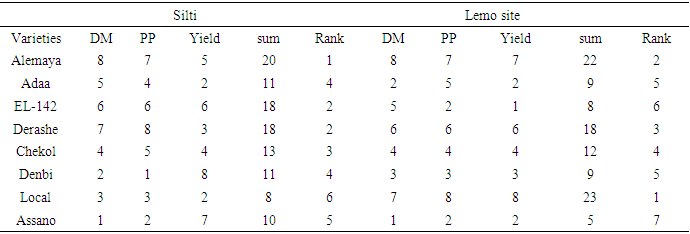-
Paper Information
- Paper Submission
-
Journal Information
- About This Journal
- Editorial Board
- Current Issue
- Archive
- Author Guidelines
- Contact Us
International Journal of Plant Research
p-ISSN: 2163-2596 e-ISSN: 2163-260X
2019; 9(2): 19-22
doi:10.5923/j.plant.20190902.01

Participatory Variety Selection of Lentil (Lens culinaris M.) in Siltie and Hadiya Zones
Mukerem Elias, Shimelis Mohammed
Southern Agricultural Research Institute, Worabe Agricultural Research Center, Worabe, Ethiopia
Correspondence to: Mukerem Elias, Southern Agricultural Research Institute, Worabe Agricultural Research Center, Worabe, Ethiopia.
| Email: |  |
Copyright © 2019 The Author(s). Published by Scientific & Academic Publishing.
This work is licensed under the Creative Commons Attribution International License (CC BY).
http://creativecommons.org/licenses/by/4.0/

Participatory variety selection trial was conducted in two districts namely of Siltie zone Silti site and Hadiya zone Lemo site of Southern Ethiopia, during 2013/14 to 2014/15 main cropping seasons with the objective of obtaining high yielding Lentil varieties and selecting farmers preferred varieties. Seven improved and one local lentil varieties were used for the experiment. Randomized Complete Block Design with three replications was used for the experiments. According to the result days to 50% flowering, days to 90% maturity, plant height, number of pod per plant, thousand seed weight and grain yield showed highly significant variation and days to 90% maturity and number of primary branches per plant had showed significant variation among the varieties. Denbi, EL-142, Assano and Local varieties had showed higher yield performance across locations. Alemaya, EL-142 and Derashe varieties selected by farmers at Silti site whereas at Lemo site Local, Alemaya and Derashe were selected by the farmers.
Keywords: Lentil, Participatory variety selection
Cite this paper: Mukerem Elias, Shimelis Mohammed, Participatory Variety Selection of Lentil (Lens culinaris M.) in Siltie and Hadiya Zones, International Journal of Plant Research, Vol. 9 No. 2, 2019, pp. 19-22. doi: 10.5923/j.plant.20190902.01.
Article Outline
1. Introduction
- Lentil (Lens culinaris M.) is an invaluable source of protein for the vast majority of Ethiopian people. It also maintains soil fertility through symbiotic nitrogen-fixation in association with Rhizobium leguminosarum bv. Viciae [1]. Lentil is one of the highland crops widely grown in Ethiopia. It is largely produced in the highland and semi-highland regions of the country mainly on clay soil [2]. The Ethiopian Export Promotion Agency reports that improved varieties yield 1.4–5.0 t ha-1 on research fields and 0.9–3.0 t ha-1 on farmers’ fields. Lentils are produced in the high altitude areas of Ethiopia. They are a winter crop, particularly important in Oromia and Amhara and also grown in parts of the SNNPR and Tigray regions. Small holder’s farmers grow the majority of Ethiopia’s lentils. Most producers follow traditional production techniques based on indigenous knowledge [3]. As CSA in, 2018 reported that out of total production area under cultivation, 119046.04 hectares of land is covered with Lentil and about 175143.56 t are produced with the productivity of 1.47 t ha-1 [4]. There are many improved varieties released by Ethiopian Agricultural Research Institute. But in the study area farmers were still used local varieties. So participatory variety selection of lentil among those varieties in Siltie and Hadiya zones was conducted to achieve the following objectives.Objectives To identify adaptable variety of lentil in Siltie and Hadiya zones.To identify farmer’s preference among released lentil varieties by using participatory approaches.
2. Material and Methods
2.1. Description of the Study Area
- The study was conducted in Siltie zone (Silti wereda) and Hadiya zone (Lemo wereda). Siltie zone is one of the zones of southern nation nationality and people regional state (SNNPRS). The zone is located 172 km apart from Addis Ababa. Siltie is one of the central zones of the region with large plain land, mountainous area, highlands concerning the climate of the zone it has two different agro-climatic conditions, Dega and Woina-dega and consisting 37% and 63% respectively. The average temperature range from 12-26°C and the average annual rainfall ranges from 780-1818mm. Silti wereda is located about 26 km from the capital town of this zone. Lentil was produced in Siltie zone 129 hectares out of this 120 hectares of land were cultivated in Silti wereda in 2011 [5]. Hadiya zone is located about 232 km apart from Addis Ababa. Its capital town is Hosanna. Latitudinal and Longitudinal extension is roughly between 7°07’-7°92’N and 37°29’-38°13’E. Annual rainfall ranges from 801mm. to 1400mm. The rainy season lasts from June to August. Temperature data obtained from Hosanna meteorology station shows that of 22.54°C. annualmean maximum temperature. Mean minimum annual temperature is 10.54°C. The size of this zone is 346958.5 hectares. From this 12.9% is Qola low altitude, 68.1% is Woina-dega and 19% is Dega or high altitude areas. Its average temperature range from 15.1-20°C, the average annual rainfall ranges from 1001-1200 mm and the elevation ranges from1501-2500 meters [5].
2.2. Methods
- The experiment was conducted at two locations for two years. Randomized Complete Block Design four replications were used. Eight varieties were used for this experiment. These are Chalew, Checol, Adaa, Alemaya, Alemtena, Assano, Teshale and local varieties. The experiment was based on a total of 24 plots and each plots had the area of 2 m by 1.6 m; 3.2 m2. The gap between the block was 1 m and the spacing between the plots 50 cm. The spacing between the raw and plant was used 20 cm and 2.5 cm respectively. 100 kg DAP per hectare was used. Farmers selected their own preferred varieties before and after harvesting at both locations. Twelve and ten farmers were participated in variety selection at Silti site and ten farmers at Lemo site respectively. Before harvesting they mainly considered the number of pod per plant and maturity days, and after harvesting they considered the yield productivity. These varieties were ranked based on these traits and gave 8 scores for the highest and 1 score for the lowest performed variety.
2.3. Data Collection
- Days to 90% maturity and plant height were collected for two years at both locations. Grain yield was measured at both locations for two seasons. Days to 50% flowering, number of pod per plant, primary branch per plant and thousand seed weight were collected for a single year at each location. Day to flowering data was counted as the number of days after planting up to 50 percent of the plant gives the first flower. Day to maturity was counted as the number of days after planting up to 90 percent of the plant matured. Number of primary branches per plant and pod per plant were counted from four plants of each central row at harvesting stages. Plant height (cm) was measured the height of four randomly selected plants from the ground to the tip of the apex and their average used for analysis. The grain yield was measured by using the yield of four central rows then converted to yield per hectare. The thousand seed weight was also measured by using the randomly taken seed of each plot.
2.4. Statistical Data Analysis
- Analysis of variance was done by using SAS (version 9.0) software package [7] based on the procedures of [8]. Varieties that showed significant difference were subjected to least significant difference (LSD) tested at 0.05 probability levels for mean separation.
3. Results and Discussion
- The combined analyses of variance (Table 1) showed that highly significant deference at (P<0.01) for days to 50% flowering, days for 90% maturity, number of pod per plant, thousand seed weight and yield per hectare across location and significant variation at (P<0.05) for number of primary branches per plant. Plant heights had showed non-significant variation. This result agrees with the finding of [9] and [10] who reported significant difference among lentil genotypes for days to flowering, days to maturity, plant height and pod per plants, with [9] and [11] for grain yield and 100 seed weight of lentil genotypes.
|
|
|
|
|
4. Conclusions and Summary
- Generally Denbi, EL-142, Assano and Local varieties were showed high yield as compared to other varieties across both location. Therefore these varieties must be distributed for the farmers through pre extension and demonstration for the study area to increase the production of lentil and farmer’s income source. Alemaya and Derashe varieties were selected by farmers at both locations. In addition to these varieties at Silti site EL-142 and at Lemo Local varieties were selected by farmers. In addition to higher yielder EL-142 and Local varieties were selected by the farmers. Therefore, based on farmer’s preference and combined analysis of variance result, Derashe, EL-142, Denbi must be recommended in addition to Local variety for these locations to increase their lentil production as well as income.
ACKNOWLEDGEMENTS
- The authors would like to thank Southern Agricultural Research Institute Worabe Agricultural Research Centre for financial support; Debre ziet agricultural research center for providing these varieties. The woreda and kebele experts participated of each districts for provide the trial land for this experiment.
 Abstract
Abstract Reference
Reference Full-Text PDF
Full-Text PDF Full-text HTML
Full-text HTML



